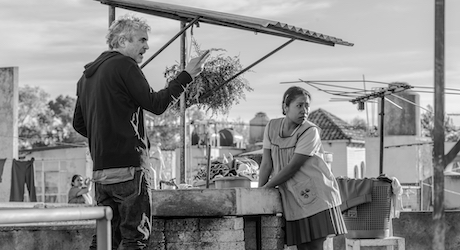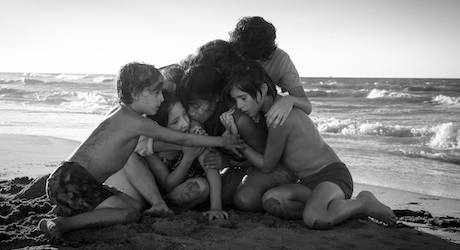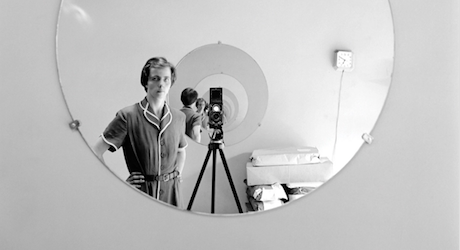“What are you doing? Just tell me!” says young Pepe. “I can’t, I’m dead,” replies Cleo, lying still on the rooftop. Pepe rolls over and shuts his eyes. “Hey, I like being dead,” Cleo says. This small scene near the start of Alfonso Cuarón’s Oscar-nominated Roma although brief is one of its most insightful. In this scene, Cleo has taken a moment away from her laundry duties to lie alongside her youngest patron and play his imaginative game. They lie there patiently as the camera takes a beat then pans up. We see the fruit of Cleo’s labour: clean clothes, washed by hand, drying in the sun across the rooftops. This is Mexico City in the 1970s, one of the largest cities in the world even then, and we inevitably catch a glimpse of similar rooftops featuring women at the helm of ceramic sinks—a silent army of domestic workers going about their daily routines. It is one of the few scenes in Roma in which we see maid Cleo take a break from her work or express a veiled opinion about her station in life.

Much of the mainstream debate surrounding Roma has been about the virtues of theatrical versus the at-home experience, but as the film settles into the Netflix catalogue, some are becoming aware that when it comes to representation, Roma falls far short in its portrayal of the working class. The film features a maid as its primary character, but she is only given value as a witness rather than as a fully formed individual.
Cuarón again is unable to face Cleo as a maid, as a person whose work enriched his life not just in her ability to rock him to sleep but also to keep his home clean. She is not valued or privileged for the order she brings to the lives of the people whose homes she works in during a season of disruption.
The opening scene is a perfect example of the the director’s aversion to Cleo’s labour. Cuarón’s first frames are of a floor tile. We hear footsteps and the distant sound of a bucket filling, followed by splashes and scrubs. Water and soap bubbles wash over the floor tiles, revealing the reflection of the sky above while the credits roll. We understand that there is something and someone pushing this water across the screen but we are not permitted, initially, to see who it is. When the camera finally pans up after the credits end, almost a whole three minutes after the first frame, we do not meet the individual responsible for the floor’s cleanliness. She is walking away from the camera down a wide driveway. When done with this particular chore, she goes into a back room away from the main home. We stay behind but hear a toilet flush. While the scene serves to establish Cleo as a maid in a well-to-do household, it also betrays the filmmaker’s guilt and possible embarrassment in observing her at work.
This continues through the rest of the film. Cleo begins or ends a task on screen but the plot dictates that the camera must pivot away from the work at every encounter. Coming as no surprise, Cuarón stylistically pays tribute to his idol Federico Fellini (even the title is a throwback to Fellini’s Roma [1972]) and chooses performance over honest reflections of a society and a time. However, unlike Fellini, who would constantly own up to the farce, Cuarón portrays his film as a reckoning for viewers to face their prejudices and see these characters directly, viewing his own work with the utmost gravity, though unaware of its shortcomings. When Cleo is shoveling dog droppings, the camera is at her feet. With Cleo taking up neither visual nor aural space, we are met with dismembered limbs, scrubbing and silence: an elegant frame but an empty signifier. Cuarón again is unable to face Cleo as a maid, as a person whose work enriched his life not just in her ability to rock him to sleep but also to keep his home clean. She is not valued or privileged for the order she brings to the lives of the people whose homes she works in during a season of disruption.
Cuarón’s paternalism runs deep and his camera—he served as his own DP—betrays an unwillingness to craft a Mexican story beyond his own sensibilities. The great tragedy of the film and the joke in its characterization as a “masterpiece” is that Cuarón is willing to show Cleo at her most vulnerable, giving birth to a stillborn child and suffering her deepest grief, yet he quivers at the possibility of watching her scrub the floor.

A similar dynamic played out in 2014 with John Maloof’s Finding Vivian Maier. Unlike Roma, this is not a personal narrative, but is the stranger-than-fiction tale of a public auction acquisition that became a phenomenon. It traces the life of a domestic worker whose photography posthumously set the art world on fire. Maloof, a historian by practice, brings us into an investigation as to why Vivian Maier, an objectively talented artist, sheltered herself by leading the life of a nanny. She is framed as an intellectual who, unlike Roma’s Cleo, is assumed to have made the choice to “slum it” in work that was beneath her. The film is only concerned with the why, continuously making the case that Vivian was an ill-suited domestic worker who should have given in to her talent and shared it with the world. Here, the decades of work as a nanny who influenced the lives of children and their families, takes a hard backseat.
[Vivian Maier] is framed as an intellectual who, unlike Roma’s Cleo, is assumed to have made the choice to “slum it” in work that was beneath her.
The clearest example of this is the film’s sly mention that Maier’s final living space was paid for in full by men whom she had once taken care of as children. These men are not featured, and they have decided not to present the Vivian of their upbringing or take credit for her care. Given the large cast of voices representing her peculiarity, extremism and, in a harrowing case, abuse, it’s unclear why we don’t hear from those who cared enough to provide for her in her old age. She must have had an impact on their lives, yet when it comes to her capacity as a nanny, the voices we hear become a chorus about her incompetence. Roma reminds us that childhood memory can be warped by a desire to capitalize on experience, so how thoroughly can we trust the memory of this chorus without counterpoint?
Maloof and co-director Charlie Siskel only have remnants of what Vivian left behind with which to attempt to bring her voice into the film. Maloof acquires a box of Vivian’s negatives from a public auction at first, but as her worth and renown as an artist grow, he acquires boxes from those who knew her, containing a large swath of her life. Negatives, audio recordings, receipts, clothes, and more are laid out for the viewer as testaments to Vivian’s existence. In evaluating these contents, Maloof doesn’t showcase anything that points to the demands of, or her commitment to, her work as a nanny. Was there nothing in her audio tapes that pointed to thoughts about her job or feelings towards the families she worked for? Instead, Maloof only features pieces that paint a picture of the artist hiding underneath—and he doesn’t bother to test his theories for validity. From the first “aha!” moment to the hoards of Tumblr comments and the consequent attention of established art galleries, Maloof is drawn into a transactional space where one woman’s life becomes another man’s asset.
“She identifies with the poor,” says one voice, characterizing Vivian’s distance from the social class she lived in. Again, Vivian is differentiated from maids like Cleo whose place as a maid goes unquestioned by class politics. Vivian is painted as an intellectual, a European, using her position as a nanny to gain the freedom to produce art—a claim the filmmakers take no time to investigate. Evidence against it supports their caricature, so why allocate real estate to this lead?

Near the middle of the film, Maloof expresses concern or guilt over exposing the work and life of such a private person. This, however, is the kick-off point for the film’s true intent. Maloof once said that is was his “responsibility to make sure her work [was] taken care of. I would never call it a business. There’s a side of it that the gallery has to represent her so we can afford to do anything financially with the archive.”1 Yet herein lies the rub. After his expression of guilt, the film begins its search for evidence that Maier wanted her work shared publicly. That she wanted to profit from her work and have it recognized. This takes the filmmaker to France where he uncovers a letter pointing to a potential business partnership involving printing postcards of her photographs. From here, the film is even less concerned with Maier’s life outside the artistic impulse. Despite the sum of her life, the “evidence” can be interpreted as, or twisted into, proof that she wanted to be artistically acknowledged. Therefore the film becomes a noble quest to celebrate vision, if not her life itself.
The end result is a film that acts as a 90-minute essay justifying the profit margin in the name of art and culture. Maloof uses the documentary form to prove that the artist intended to be found, to be celebrated—that over her lifetime she had crafted a persona for this final act that would take place after her death. Maloof then fashions himself as an executor of her will, a noble character himself.
In both Roma and Finding Vivian Maier we are reminded that in life as in death we are all free game in a race to profit from culture. Cuarón and Maloof seemingly did not intend for their films to betray their protagonists nor to incur such strong reactions in the #MeToo era. However, we must ask ourselves where the filmmakers’ inherent limitations and unwillingness to sacrifice ego meet in attempting to portray the experiences of working-class women.
Both films offer a map onto which can be traced a tendency to use the working class and women’s cultural capital to compensate for the filmmakers’ limitations, no matter stated or internalized intent. Roma takes advantage of this capital in as far as Cuarón has allowed the film to be characterized as Cleo’s story rather than the kaleidoscopic revisiting of a moment in the filmmaker’s life, and his cultural competence rings hollow. Finding Vivian Maier follows in its singular pursuit of an artist rather than the whole person.





